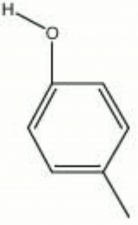Difference between revisions of "Cresol"
Jump to navigation
Jump to search
(username removed) |
|||
| (6 intermediate revisions by 3 users not shown) | |||
| Line 1: | Line 1: | ||
== Description == | == Description == | ||
| − | A yellowish oil with a phenolic odor that is a constituent of [ | + | A yellowish oil with a phenolic odor that is a constituent of [[creosote oil (coal tar)|coal tar creosote]]. Cresol is used as a parasiticide and a [[disinfectant]] ([[Lysol|Lysol®]]). It is also used in photographic developers. |
== Synonyms and Related Terms == | == Synonyms and Related Terms == | ||
| Line 8: | Line 8: | ||
[[[SliderGallery rightalign|cresol.jpg~Chemical structure]]] | [[[SliderGallery rightalign|cresol.jpg~Chemical structure]]] | ||
| + | == Risks == | ||
| − | == | + | * Irritating to skin, eyes and nose. |
| + | * Toxic by ingestion and inhalation. | ||
| + | * Hygroscopic. | ||
| + | * Light sensitive. Air sensitive. | ||
| + | * Corrosive. | ||
| + | * Flash point = 82 C ( 179.60 F) | ||
| + | * Fisher Scientific: [https://www.fishersci.com/store/msds?partNumber=AC110581000&productDescription=M-CRESOL%2C+99%25+100GR&vendorId=VN00032119&countryCode=US&language=en SDS] | ||
| + | * EPA lists cresol and cresylic acid as hazardous waste due to toxicity; concentrations over 10% must be disposed of appropriately | ||
| + | ==Physical and Chemical Properties== | ||
Soluble in water. Miscible in ethanol, benzene, ether, glycerol and alkalis. | Soluble in water. Miscible in ethanol, benzene, ether, glycerol and alkalis. | ||
| Line 22: | Line 31: | ||
|- | |- | ||
! scope="row"| Density | ! scope="row"| Density | ||
| − | | 1.03 | + | | 1.03 g/ml |
|- | |- | ||
! scope="row"| Molecular Weight | ! scope="row"| Molecular Weight | ||
| Line 31: | Line 40: | ||
|- | |- | ||
! scope="row"| Boiling Point | ! scope="row"| Boiling Point | ||
| − | | 195-205 | + | | 195-205 C |
|} | |} | ||
| − | == | + | == Resources and Citations == |
| − | |||
| − | |||
| − | |||
| − | |||
| − | |||
| − | |||
| − | |||
| − | |||
| − | |||
| − | |||
* G.S.Brady, ''Materials Handbook'', McGraw-Hill Book Co., New York, 1971 Comment: p. 251 | * G.S.Brady, ''Materials Handbook'', McGraw-Hill Book Co., New York, 1971 Comment: p. 251 | ||
Latest revision as of 12:52, 17 April 2024
Description
A yellowish oil with a phenolic odor that is a constituent of coal tar creosote. Cresol is used as a parasiticide and a Disinfectant (Lysol®). It is also used in photographic developers.
Synonyms and Related Terms
cresylic acid; cresylol; tricresol; methylphenol; hydroxymethylbenzene; 3-cresol; 3-m-hydroxytoluene; m-cresylic acid;1-hydroxy-3-methylbenzene; m-oxytoluene;
Risks
- Irritating to skin, eyes and nose.
- Toxic by ingestion and inhalation.
- Hygroscopic.
- Light sensitive. Air sensitive.
- Corrosive.
- Flash point = 82 C ( 179.60 F)
- Fisher Scientific: SDS
- EPA lists cresol and cresylic acid as hazardous waste due to toxicity; concentrations over 10% must be disposed of appropriately
Physical and Chemical Properties
Soluble in water. Miscible in ethanol, benzene, ether, glycerol and alkalis.
| Composition | CH3C6H4OH |
|---|---|
| CAS | 1319-77-3 |
| Density | 1.03 g/ml |
| Molecular Weight | mol. wt.=108.14 |
| Refractive Index | 1.542 (m-cresol) |
| Boiling Point | 195-205 C |
Resources and Citations
- G.S.Brady, Materials Handbook, McGraw-Hill Book Co., New York, 1971 Comment: p. 251
- Richard S. Lewis, Hawley's Condensed Chemical Dictionary, Van Nostrand Reinhold, New York, 10th ed., 1993
- The Merck Index, Martha Windholz (ed.), Merck Research Labs, Rahway NJ, 10th edition, 1983
- CRC Handbook of Chemistry and Physics, Robert Weast (ed.), CRC Press, Boca Raton, Florida, v. 61, 1980 Comment: ref. index=1.542 (m-cresol)
